Kobo Touch eReader Review
Kobo Touch eReader
We may not have the Kindle Touch here in the UK, but the Kobo Touch is here to fill that gap.
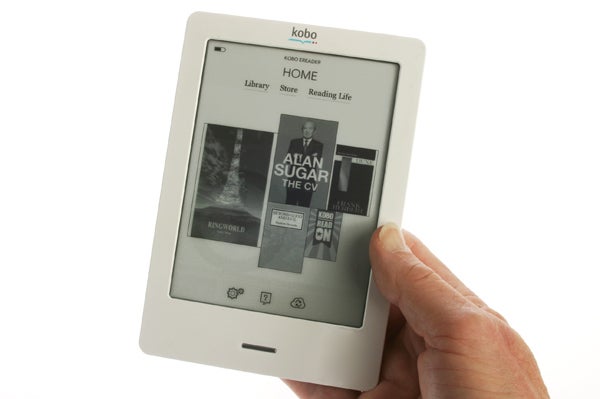
Verdict
Pros
- Slim and light
- Attractive
- Decent E-ink Pearl screen
Cons
- Slightly slower than the best
- Kobo Store just OK
Key Specifications
- Review Price: £109.00
- 2GB internal memory
- microSD slot
- 6in E-ink Pearl screen
- Built-in Wi-Fi
- Touchscreen
The Amazon Kindle dominates the ereader market more the iPad does in tablet town. Many people couldn’t name an ereader apart from the Kindle. The Kobo range is here to change all that. Partnering with high street giant WHSmith, Kobo offers a pair of eink readers, both attractive in price and design. Today we’re looking at the more expensive model, which is equipped with a touchscreen.
Few manufacturers of eink readers have demonstrated an understanding of what an ereader should be like as well as Kobo has with this device. The Kobo Touch is petite, simple, light and attractive – and yet for all its daintiness, it feels strong too.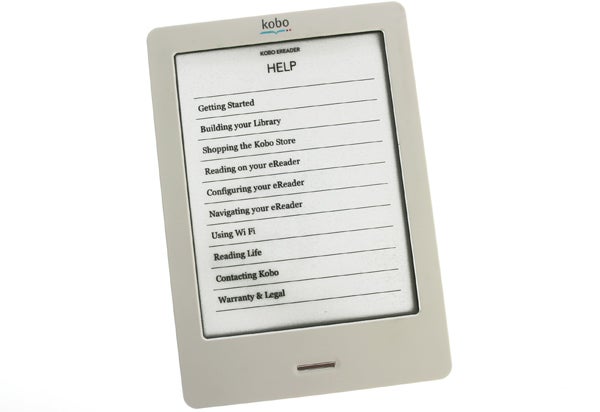
It weighs 183g, which is a little bit heavier than the new £89 Amazon Kindle, but is just as comfortable to hold one-handed. The whole of the device is finished in soft-touch plastic and feels delightful. With no physical page turn buttons and just a single seam on the back of the device, it’s cuter and prettier than the Kindle.
The Kobo Touch is much closer to the Kindle Touch than the 2011 Kindle in looks, but that model is yet to come to the UK – and as yet Amazon has not revealed a date for its arrival. This is a major win for the Kobo, with Christmas around the corner.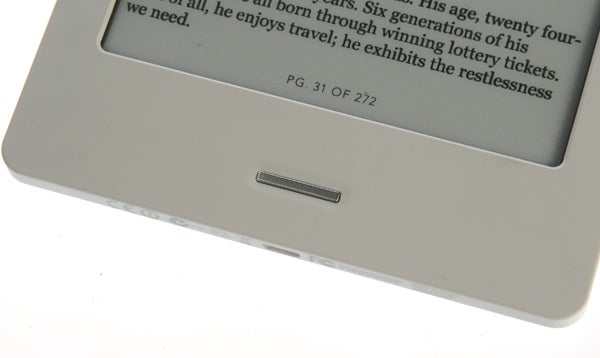
A quilted back ensures this is no flat-out Kindle copy too. It sounds a bit naff, a back textured with a pattern seen on jackets worn by rich middle-aged people taking their beagles out for a walk, but it just works. The quilted back further softens the design, making it seem friendlier and less severe than it otherwise would. When put under stress, the Kobo Touch doesn’t flex or bend at all, but the impression in-hand is not of something too hard and immovable.
It’s 10mm thick and has a 6in screen, giving it similar dimensions to many readers of the past few years, most notably Sony’s touch models. This screen size has become the standard for devices of this type, and there are only a few that stray from it, such as the old Kindle DX and the dinky Sony PRS-350.

There are just two sockets about its body, one microUSB to transfer files and charge the battery and a microSD slot to let you expand upon the 2GB of internal memory. It’s a neat addition but not a must-have – ebooks take up so little storage that we find the internal memory sufficient.
There are also just two physical controls – a Home button on the front and a power slider up top. This minimal design looks great, and means you can hold the Kobo up proudly on the train or bus without feeling like you’ve bought the Kindle’s poor relation.
The Kobo Touch uses an E-ink Pearl screen capable of rendering 16 shades of grey. In a world of phones that can display 16.8 million colours it might not sound like much, but this spec holds plenty of weight in the ereader arena. The screen quality compares reasonably well with our current favourites, including the Kindle and Sony PRS-650, although contrast isn’t quite as good. Text is nice and dark, but the background is slightly greyer than the best.
Naturally, it gives the paper-like, non-glare reading experience that makes E-ink readers so worthwhile, as opposed to LCD-screened counterparts. It makes no bold steps forward, though, and there are some elements that will improve in E-ink technology over the next six months or so, most important of all being screen resolution. All the big-name ereaders of the moment use 800×600 pixel screens – not quite enough to keep smaller text looking ultra-sharp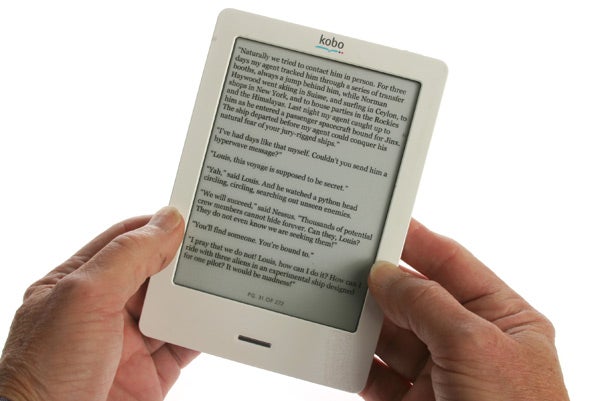 .
.
Short of opting for the smaller Sony PRS-350, which has a 5in screen and 800×600 resolution – or waiting for iRiver’s 1024×768 pixel Story HD, you can’t do any better at present. The Story HD is likely to be the first high-resolution model to market, although other manufacturers may have goodies in store soon, Kobo included. The imperfect text rendering only becomes apparent if you approach the screen with real critical scrutiny, though. Thanks to the way E-ink technology works, its pixellation is nowhere near as offensive to the eye as LCD pixellation.
The touchscreen works very well during reading, for the most part. You can turn pages by either tapping or swiping on the left or right edges of the screen, and there are several customisation options for this, which we’ll cover later. If you’ve used an ereader with physical buttons, you’ll miss them for a while, but touchschreen operation works well. The one slight annoyance is that it ignores gestures if they use vertical movement – and in some of our late night reading sessions screen taps too easily become slight drags up or down the screen, and hence were ignored.
The Kobo Touch doesn’t use the common resistive or capacitive screen types, instead using the same technique as Sony’s touch Reader models. Particles are fired across the screen, and as your finger interrupts this flow, the screen can extrapolate where it is. No direct pressure is required – just the lightest of touches will suffice.
Where the Kobo Touch reading experience falls behind the top performers a bit is speed. It reportedly uses the same 800MHz Freescale 9.MX508 processor as the 2011 Kindle, but page turn speed is closer to that of the previous-gen Amazon model – not sluggish but not blazingly fast either. Kobo may address this in a firmware update.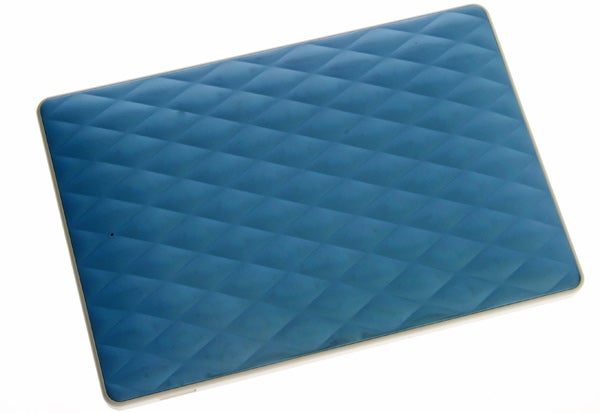
You can get a bit more speed by changing how often the screen performs a full refresh. Unusually, Kobo gives you full control over the refresh cycle. You can make it refresh fully at every page turn, or just once every six turns – or any regular frequency between these points.
The bonuses of a partial refresh are that you don’t get the unsightly black flash ereaders are famous for and that it’s quicker than a full refresh. The drawback is the slight residue left by the previous page’s text. It won’t bother some, but can cause headaches in others. Having full control here wins the Kobo several brownie points and a smiley sticker.
A comprehensive array of features that come in handy during reading are here too. Hold a finger down on a word to select it and you can look it up in the built-in Merriam-Webster dictionary; mark it as a note; search for it throughout the book; translate it between English, Italian, Spanish, German and French languages; or even post it to Facebook. This may sound like a bewildering array of options, but it’s all very intuitive in use, as – like the design – Kobo has aced the reader’s interface.
In Kindle-esque fashion, the Kobo Touch’s home screen’s primary aim is to get you back into your book as quickly as possible. Cover images of the last five books or documents you have read appear in thumbnail form in the centre, while the menu shortcuts are relegated to the top and bottom of the screen. Tap on one of the thumbnails and you’re taken directly to your last point of reading. The layout is highly intuitive and looks great too. It’s classy, and geared towards the way people are likely to use it – which is a rarer occurrence than you might think in consumer electronics.
To complement its neat-looking interface, the Kobo Touch has a fun, breezy style that should especially appeal to younger folk, or parents looking to push reading onto their kids through the medium of tech. By reading, you can unlock achievements in the style of the trophies of the Sony PS3 or achievements of the Microsoft Xbox 360.
There are 18 in total, and generally involve either reading for a certain length or in a certain way, or using the Kobo’s secondary features, like Facebook integration. They won’t last too long but are executed in a manner inoffensive enough to avoid the scorn of all but the most dedicated of curmudgeons. 
This is one half of the Kobo Touch’s Reading Life section, which claims one of the links on the home screen next to your Library and the Kobo Store. We find the other half of Reading Life much more interesting.
It tells you how long you’ve spent reading your current book, how many pages you’ve turned and how long your average reading session is. Below this info are figures for how many books you’ve completed on your Kobo, your total hours spent reading and how much of your library you have read. Although not something we’d imagine many will use all that regularly, it’s an interesting resource, whether it represents a “game-ification” of reading or not.
Stepping away from the frivolous side and back to reading, the Kobo Touch gives you plenty of customisation options other than just how often a full screen refresh is performed. There are seven fonts to choose from, 24 font sizes, plenty of customisation of line spacing and margins plus three justification options. This is arguably choice overkill, but as ever it’s relayed in a fairly digestible manner with its own pop-up menu.
There are also three options that dictate how the touchscreen behaves while you’re reading. Either side can be used to go forward a page, showing consideration for the left-handers among us. And you can give the menu shortcut equal or lesser space on the touchscreen – with the lone physical button forever dedicated to taking you to the home screen, the touchscreen has to do the rest. Ereader newcomers may take a while to find their favoured setting, but we expect that the vast majority will stick with a single setup after a while.
The Kobo Touch gives you full access to its internal memory, so if you have an existing library of ePub files you want to read, it’s happy to oblige. However, it also offers the Kobo Store, Kobo’s answer to the Amazon Kindle Store.
To get started you need to create and account on your PC or Mac and link it to the ereader by plugging it into your computer while the free Kobo app is running. While the two million-strong library sounds good, navigation of it on a computer isn’t so hot. This is especially apparent when browsing using a computer, where the passage through subcategories feels clumsy and the software a bit under-optimised at this point.
It looks reasonably good, but is nowhere near as convenient as being able to buy a book on the Amazon website and have it beamed to your reader automaticallyonly, as you can with a Kindle. Loading the store on the Touch itself, using the built-in Wi-Fi, was also a little slow.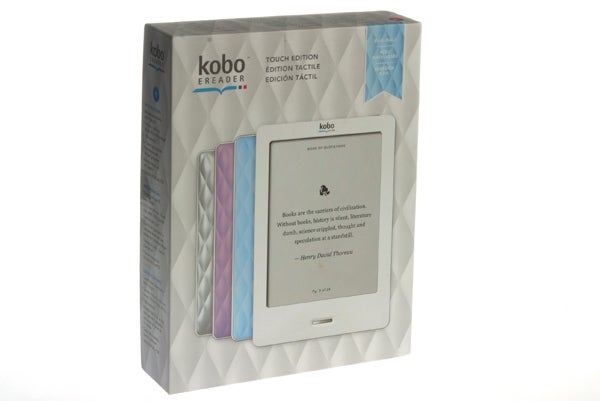
Prices aren’t hugely attractive either, and it’s not a great discovery tool. There are plenty of categories and a cheap reads section, but you can’t tap on an authors name to see their other books and it doesn’t assess your collection to suggest titles you might like. However, there’s plenty of scope for Kobo to tweak the Store experience over the coming months.
The Kobo Store does offer multi-page previews of titles and has plenty of free books, but it’s only the Project Guttenburg fare you could snap up independently of the Store. At the time of writing, no newspapers or magazines were available to us UK folk – even though there is a section specifically for this content. To the Store’s credit, the Kobo Touch allows Wi-Fi sync, removing the need to connect to your computer directly after the initial setup.
Competing with an infrastructure as developed as Amazon’s is always going to be tough, and the Kobo option looks a lot rosier when squared up against other manufacturers’ models instead. It does offer ePub support, though, still missing from the Kindle line-up. Kobo also supports the formats demanded by the UK’s main ebook lending services.
According to Kobo’s documentation on the Touch, it can read CBR and CBZ comic book files too, but it refused to recognise the CBR books we uploaded to the device. Further investigation revealed it’s a problem with the current firmware, and should hopefully be fixed soon.
These are neat extras, but probably aren’t going to convince comic book nuts – thanks to the lack of colour. The Kobo Touch is keen on extras like this support and the reading achievements, so much so that – like the Kindle – it has its own “superfluous features” section. Within it, there’s Sudoku, a basic web browser and a sketchbook. Kobo says these features are “not officially supported”, but Sudoku in particular is a neat addition. Like other ereader web browsers, this one is slow and rudimentary – really just there to make further use of the built-in Wi-Fi.
Kobo has clearly been careful not to miss out on any important features of its key rivals – it’s an aggressive and carefully-specced product. Even if the Kindle Touch were available in the UK, we can’t imagine it would be any cheaper than the Kobo Touch.
For all its efforts, it doesn’t do quite enough to make us stop wanting the touch-enabled Amazon offering, or wipe out the memory of the Sony PRS-350. It’s a tiny bit slow considering the generation of ereaders it’s a part of, and the Kobo Store has some way to go before it can be considered in the same league as the Amazon Kindle Store. However, it’s imbued with a sense of style and fun that makes it very likeable – in a way that most previous smaller-name ereaders aren’t. If you need a touchscreen reader now, the Kobo Touch, Sony PRS-350 and PRS-650 are the only models to consider. And this is the cheapest of the lot.
Verdict
The Kobo Touch is the latest ereader to take on the high street buyer. And for the most part, it’s a great success. It’s thin, light, attractive and has an E-ink screen on-par with the best out there. On pure speed it can’t match the latest Kindle, and the Kobo Store could do with some optimisation, but if you need a touchscreen ereader, this is the best-connected option available in the UK.
Trusted Score
Score in detail
-
Value 8
-
Features 9
-
Design 8


